
So many people spend hundreds of dollars on a good sewing machine, use it for a few months and then they give up, and put it back in the box in the basement where it remains for years –untouched. Somewhere in their sewing journey, many aspiring sewers become afraid or demotivated because the project did not turn out the way they wanted.
A big pile of unfinished garments is a dead giveaway! Our brain is trained to look for inconsistencies and it is how we judge beauty. Unconsciously, we know something is off and we give up before we finish. The reason for this doomed journey starts at the fabric store but is often made worse by how we end up cutting the fabric. Here are my top 5 mistakes to avoid when cutting fabric.
The reason for this doomed journey starts at the fabric store but is often made worse by how we end up cutting the fabric. Here are my top 5 mistakes to avoid when cutting fabric.
#1. Not washing the fabric before cutting.
Natural fibers come from vegetable material (cotton, hemp, flax, etc) or animals (wool, cashmere, silk, alpaca, etc). Below I have tested a 100% cotton swatch measuring 10 x 10cm, I soaked and washed the swatch and ironed it with a very hot iron. As you can see in the second photograph the swatch shrunk considerably, this is because when fabrics are being woven the fibers are being tensed.
When these fibers come in contact with water they relax, but by applying heat once again, the fibers go back to their original state. This process is similar to how a spring works. Normally it will take several washes for some fabrics to relax. A good example of this is cotton and linen. Both fabrics become smooth after a few washes, but when too much heat is applied –for example when we forget the cloth in the dryer for too long– the size of the garment will shrink considerably.
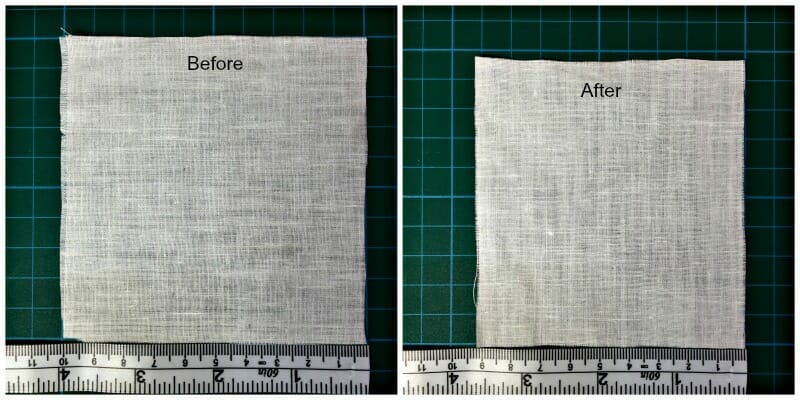

#2. Not squaring and truing the fabric.
To understand squaring and truing we need to learn a couple of terms that relate to fabrics. In the picture below, the yarn being pulled is called the weft. The yarn that runs perpendicular to it is the warp. In order to true the fabric we need to make a cut on the weft, pull the thread, and cut in the space that is left by the thread, as is seen in the picture.
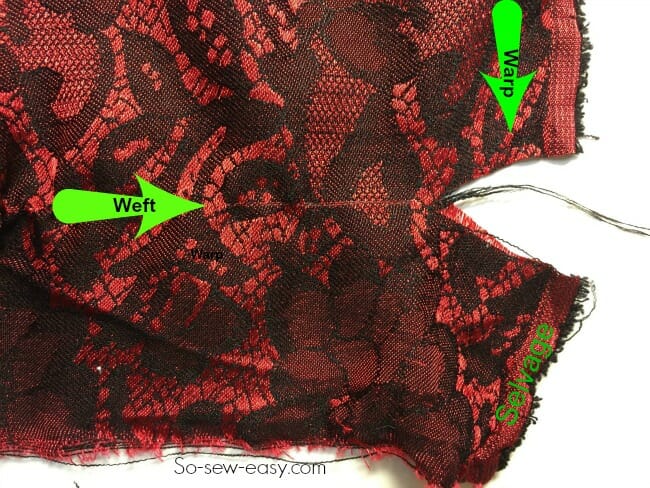

To be able to square the fabric you must cut away the selvage which is the fuzzy edge that runs along the length of the fabric or, as is known, the warp of the fabric. Cut away the edge by making a cut and pulling the thread and cutting the same way you did with the weft or the horizontal thread.
Sometimes when you go to the fabric store, the chatty woman at the counter makes a cut in the fabric and rips your piece out, this action actually distorts the shape of your fabric. In the following picture, you can see the effect of this action. I lost almost a bit more than a 1/4 of a yard getting the fabric to have a uniform edge!
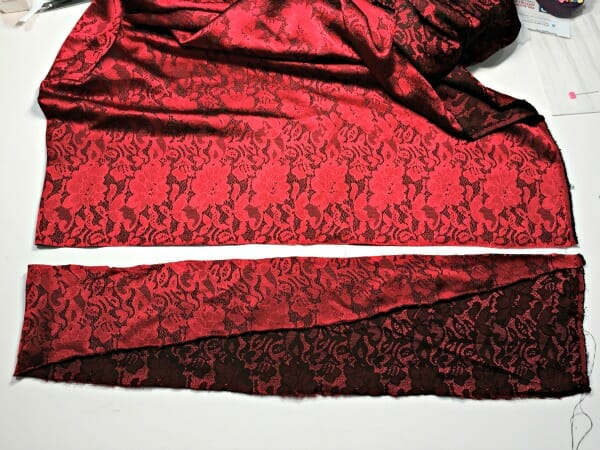

To square the fabric, after you have taken the selvage out, get someone to help you pull one corner of the fabric while you pull the diagonal corner, change and do the other corners. You are trying to restore the shape of the fabric. This step is particularly important if you are using a cotton/elastane combination.
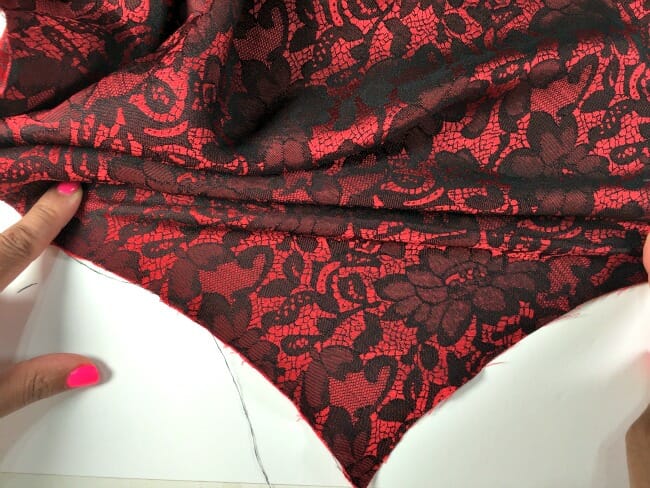

#3. Not following pattern instructions for placement of the fabric grain.
Ending up with something so tight that it looks like Shapewear or a too-short mini skirt because you didn't shrink your fabric before sewing is still not as bad as not using the grain of the fabric to place your pattern. To find the grain of your fabric, all you have to do is square and true the fabric, join the side where the selvage was, and fold the fabric.
The fabric grain is indicated on the pattern as the long arrow that runs the length of the pattern piece it will cause the fabric to hang correctly because it will be cut at a right angle. Not only does it look bad, it's annoying to wear because your skirt or pants will keep twisting around or clinging to you, but more importantly, the pieces of your pattern will not match. This is simply because the fabric will stretch at an angle. A perfect example of this is a skirt cut on a bias. We've all had t-shirts where they cut slightly off grain to save time and can twist around the torso.
Avoid this by making sure to place your pattern pieces accurately on the grain when you cut out your patterns. You can achieve this by measuring the distance from the selvage to the grain arrow and making sure it is equidistant, as shown in the picture below.
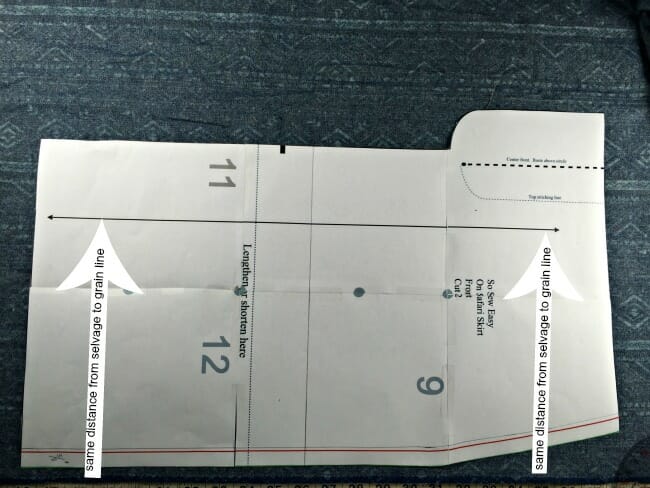

#4. Not having enough fabric to match plaids or stripes.
This is the classic mistake easily avoided by buying more fabric and placing the pattern so it matches the prints or plaid. On your pattern, mark where the most prominent color is. In my example below, I have marked the brown color in all the pattern pieces, because is the most dominant, notice how you actually will use more fabric because not only do you have to use the direction of the color, but also you have to maintain the grain of the fabric. As a rule, how much fabric you will need, will always depend on your size and the width of the fabric you intend to use.
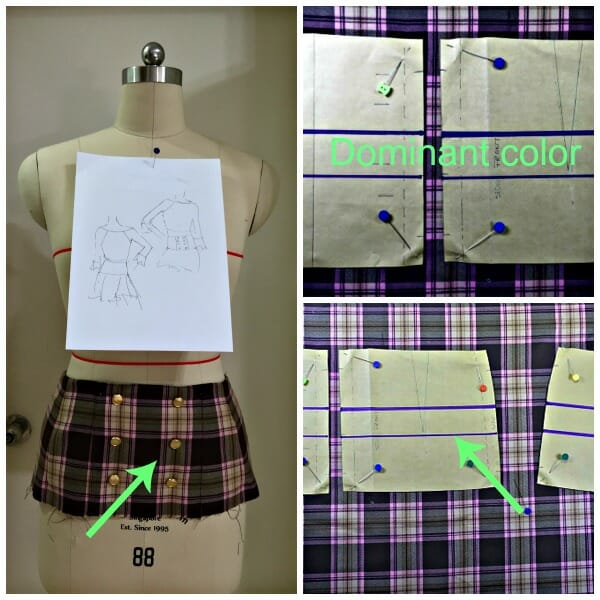

#5. Using the wrong fabric.
Thin silky fabric will not make an appealing jacket due to its lack of structure. It would, however, make a very good lining. A knit fabric will perform differently from a woven fabric because of the stretchability of the knit, therefore, the pattern pieces on a knitted garment are going to be less wide than normal patterns. All Patterns will give you suggestions for what fabrics to use. It is possible to substitute the fabric according to its drapability.
Follow the instructions on the back of the envelope to the letter. It will be clearly marked what kind of fabric will be best suited for the pattern, study the drawing, see how the garment falls away or clings to the body. Look at the illustration and try to match what the designer has used. For a sample of swatches and their common uses please watch this video:
It is easy to get excited when inspiration strikes us, and we want to get things done quickly, but by not avoiding these 5 common Mistakes To Avoid When Cutting Fabric, you will only be sabotaging your own efforts and creativity. Taking the time to prepare your fabric may sound boring but it is essential for a good sewing outcome.
Thank you for reading, and Until Next Time, Happy Sewing!








Im not convinced about not tearing the fabric – it SHOULD tear with the weft perfectly. It’s easy to check because you should be able to pull a thread close to the edge easily. It will have a bit of a roll, but than can be pressed out or trimmed off. The piece in your picture looks like it was stretched out of true when it was rolled;which happens often. I sewed curtains professionally for many years, and very often tore the fabric. Admittedly there was one particular fabric that was a bit slippery where I absolutely had to pull a thread to get a straight cut. I’m no expert, it’s just my opinion.
I did not see the yardage requirements for the different fabric widths and the different dress sizes. should I first cut out and join the fronts and backs to estimate the yardage needed?
Yes, I never put that info simply because it would take me another couple of hours that I frankly do not have. What you can do is print the pattern and work out the yardage you require for the size and width you are going to be using. Not sure what pattern are you looking for but normally I mention what I am using and how much. If you still need further help let me know via email. mayra@so-sew-easy.com
Sister Margarite, Notre Dame Nun, home economics instructor with the patience of a saint would be pleased that you ‘match the plaids’ We were discussing plaids in class and I was wearing a skirt and vest. I was asked to stand up so the class could see my outfit and discuss. I never noticed that not only did the plaids not match but the skirt and vest plaid were not going in the same direction. I never wore that outfit again and and never again would I not ensure that everything matched! I realize it takes time and and therefore money in home clothing construction and in ready-to-wear to ensure matching but it is so worth the effort. I have seen some rather expensive clothing and think with just a little more care this could have been beautiful. I even have my shopping buddies verifying good matching.
Maybe make it 6 mistakes
Layout pattern pieces on fabric, just to make sure you have enough material for the layout.
Hi Linda, thanks for this addition to the list.
I began learning to sew over 60 years ago and I enjoy reading your posts very much.
You’re a wonderful teacher, just like the one I had back then – my mother. She helped me develop a love of sewing that’s still with me today. I find it fun and relaxing, and it’s been very helpful in these days of the Covid-19 quarantine situation; I’m never bored and I always have something to do.
For all these years, I have kept the machine she used to teach me. It’s a 1948 or ’49 White Rotary 77 mounted in a cabinet. It has “pride of place” in my family room where I can look at it and visualize her sitting there, sewing something for one of us kids. She’s been gone for many years and I miss her still, but the memories are wonderful.
You and she have something in common. Her name was Ellen Cecilia. I wonder – could he name Cecilia mean Teacher? ????
You made me cry, the picture of your mother at the sewing machine what a great memory, greatest till having the machine still working. To me is an honour to carry this name that has been in my family for generations. So thank you…sending you a virtual hug.
OMG! I never saw your reply until now; how embarrassing! I loved your response and I’m sending you a virtual hug in return. You’ve touched my heart!
I think my mother had the same machine.
And Cecelia is the name of the saint who is the patron saint of singing: the girls’ choir in my church was named “St. Cecelia’s choir.” I never heard that she was a teacher.
I have a piece of material with a pattern of lace and the selvage edge has a lacy finish my problem is if I want the edge of the sleeve to have the lacy edge I will be cutting against the grain Help
Hi Fran, that is not the end of the world, it is true that you need to cut on the grain, but this rule relaxes when you have to put the design first. Go ahead and cut the sleeve with the edge of the lace used as the hem of the sleeve. This question is a great idea for me to explain in detail the grainline and its effect on the design. Thank you for the inspiration.
All great but people do not realize ironing seams 3-ways.
Indeed it is important, but this article is about what to have in mind before cutting fabric. Thank you have given me an idea for a follow up article.
This is exactly what I learned in my home economic class. And that was in 1969, That you so much for the review!!
This is the beauty of sewing, machines and fabrics change, instructions remain the same.
You make such valid points and this is not rocket science. I have learned that just taking that few minutes to check all these points saves a lot of head ache and regret. thank you so much for making things easier for all of us xx
My Pleasure Jackie, glad you take the time to save time and disappointment.
I love this post! My mom taught me how to sew at a very young age, but I have been away for a few decades. So, for now I will say I’m a temporary newbie, who wants to make her grandchildren clothes as well as my own. I found it interesting that we’re supposed to prewash our fabrics, but I never recall my mom prewashing before cutting the pattern, but I will definitely try it.
I’m grateful/thankful that I found this website in such of understanding what 40″, 60″ meant as it relates to the fabric and what should we do when we can only find 51″?
Hi Angelina, not sure what you mean so I am assuming you mean how to place the pattern on the fabric? Is this is so I just wrote this article that I think you will find useful https://so-sew-easy.com/avoid-waste-buying-fabric/. Let me know if you have any other question, a comment is the best way to get help. If I don’t know the answer someone among the readers will answer it for you.
I think you mean the WOF (width of fabric) measurements? If so, usually the back of the pattern envelope will give you different yardage requirements based on the WOF. The requirements for nap, directional, plaids & stripes, etc. are also listed. Just take your time & read all of this before having them cut fabric for you at the store. Also, as Mayra Cecilia says, use appropriate fabrics, as suggested on the envelope. However, I always leave the selvage on the fabric because it gives a point of reference, so I know which way is the Grain line. DO NOT ever include the actual selvage within the cutting area. Additionally, when using sleek, silky fabrics, the selvage helps to stabilize the fabric while handling it during cutting preparations.